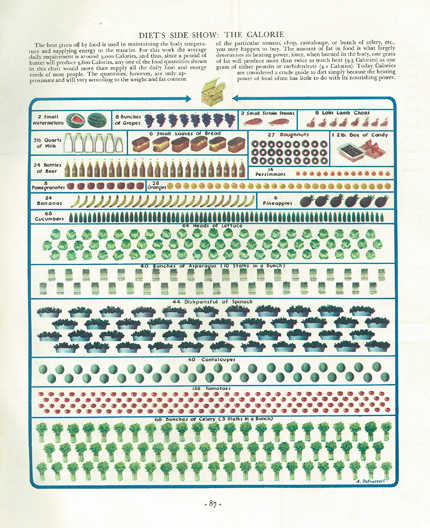
lllustration of different food quantities with the same caloric value, from "The Wonders of Diet"
Excerpt from "The Wonders of Diet," Fortune magazine, May 1936
FOOD LEGENDS
More food notions flourish in the U.S. than in any other civilized country on earth, and most of them are wrong. They thrive in the minds of the same people who talk about their operations; and like all mythology, they are a blend of fear, coincidence, and advertising. Examples:
Tomato juice is the best cure for a hangover.
Celery and fish cannot be eaten together.
Green fruits are poisonous.
Meat makes you sensual and belligerent.
Six-day bicycle racers need beefsteak.
Garlic purifies the blood.
Cream or milk should not be eaten with lobster or pickles.
“Heavy” foods are indigestible.
Smoking aids digestion.
Fruit juice should start the breakfast.
Soft foods will make your teeth decay.
Raw eggs are more digestible than cooked eggs.
Clear coffee is less harmful than that sugared and creamed.
Excessive meat eating causes high blood pressure, rheumatism, gout.
Belching means indigestion, bicarbonate of soda cures it.
Acidosis means acid stomach.


Comments [4]
09.23.09
12:05
"The heat given off by food is used in maintaining the body temperature and supplying energy to the muscles. For this work the average daily requirement is around 3,000 Calories, and then since a pound of butter will produce 3,600 Calories, any one of the food quantities shown in this chart would more than supply all the daily heat and energy needs of most people. The quantities, however, are only approximate and will vary according to the weight and fat content of the particular …, chop, cantaloupe, or bunch of celery, etc, you may happy to buy. The amount of fat in food is what largely … in heating power, since, when burned in the body, one gram of fat will produce more than twice as much heat (3.3 Calories) as one gram of either protein or carbohydrate (??? Calories). Today Calories are considered a crude guide to diet simply because the heating power of food often has little to do with its nourishing power."
09.23.09
01:29
DIET'S SIDE SHOW: THE CALORIE
The heat given off by food is used in maintaining the body temperature and supplying energy to the muscles. For this work the average daily requirement is around 3,000 Calories, and thus, since a pound of butter will produce 3,600 Calories, any one of the food quantities shown in this chart would more than supply all the daily heat and energy needs of most people. The quantities, however, are only approximate and will vary according to the weight and fat content of the particular tomato, chop, cantaloupe, or bunch of celery, etc, you may happen to buy. The amount of fat in food is what largely determines its heating power, since, when burned in the body, one gram of fat will produce more than twice as much heat (9.3 Calories) as one gram of either protein or carbohydrate (4.1 Calories). Today Calories are considered a crude guide to diet simply because the heating power of food often has little to do with its nourishing power.
09.23.09
01:56
-Lauren
01.12.10
12:17